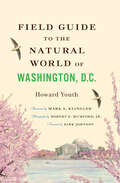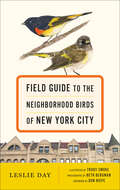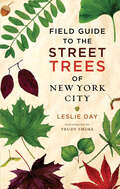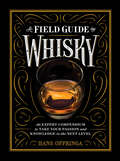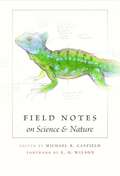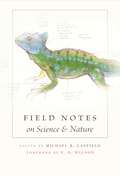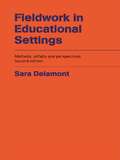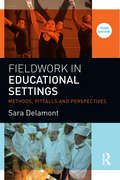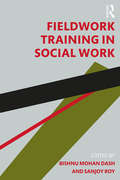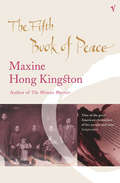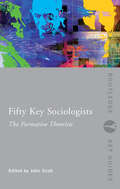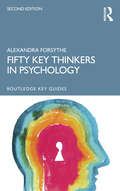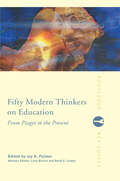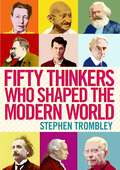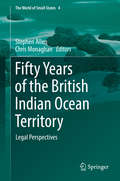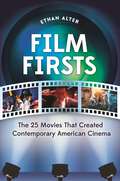- Table View
- List View
Field Guide to the Natural World of Washington, D.C.
by Howard YouthNature awaits discovery at almost every turn in the complex ecosystem of Washington, D.C. In parks large and small, within the District's gardens, and on public streets, there is tremendous biodiversity. In Field Guide to the Natural World of Washington, D.C., naturalist Howard Youth takes us on an urban safari, describing the wild side of the nation's capital.Beyond the abundant wildlife that can be seen in every neighborhood, Washington boasts a large park network rich in natural wonders. A hike along the trails of Rock Creek Park, one of the country’s largest and oldest urban forests, quickly reveals white-tailed deer, eastern gray squirrels, and little brown bats. Mayapples, Virginia bluebells, and red mulberry trees are but a few of the treasures found growing at the National Arboretum. A stroll along the Potomac and Anacostia Rivers might reveal stealthy denizens such as bullfrogs, largemouth bass, and common snapping turtles. Detailed drawings by Carnegie artist Mark A. Klingler and photography by Robert E. Mumford, Jr., reveal the rich color and stunning beauty of the flora and fauna awaiting every D.C. naturalist.Whether seeking a secluded jog or an adventurous outing, residents and tourists alike will find this handsome guide indispensable for finding oases away from the noise of the city.
Field Guide to the Neighborhood Birds of New York City
by Leslie Day Don RiepeLook around New York, and you’ll probably see birds: wood ducks swimming in Queens, a stalking black-crowned night-heron in Brooklyn, great horned owls perching in the Bronx, warblers feeding in Central Park, or Staten Island’s purple martins flying to and fro. You might spot hawks and falcons nesting on skyscrapers or robins belting out songs from trees along the street. America’s largest metropolis teems with birdlife in part because it sits within the great Atlantic flyway where migratory birds travel seasonally between north and south. The Big Apple’s miles of coastline, magnificent parks, and millions of trees attract dozens of migrating species every year and are also home year-round to scores of resident birds. There is no better way to identify and learn about New York’s birds than with this comprehensive field guide from New York City naturalist Leslie Day. Her book will quickly teach you what each species looks like, where they build their nests, what they eat, the sounds of their songs, what time of year they appear in the city, the shapes and colors of their eggs, and where in the five boroughs you can find themâ€�which is often in the neighborhood you call home. The hundreds of stunning photographs by Beth Bergman and gorgeous illustrations by Trudy Smoke will help you identify the ninety avian species commonly seen in New York. Once you enter the world of the city’s birds, life in the great metropolis will never look the same.
Field Guide to the Street Trees of New York City
by Leslie DayImagine an urban oasis with hundreds of thousands of trees and whose mayor wants to plant a million more. That sylvan place is New York City, and this is a guide to the diverse trees that line its streets.Field Guide to the Street Trees of New York City acquaints New Yorkers and visitors alike with fifty species of trees commonly found in the neighborhoods where people live, work, and travel. Beautiful, original drawings of leaves and stunning photographs of bark, fruit, flower, and twig accompany informative descriptions of each species. Detailed maps of the five boroughs identify all of the city’s neighborhoods, and specific addresses pinpoint where to find a good example of each tree species. Trees provide invaluable benefits to the Big Apple: they reduce the rate of respiratory disease, increase property values, cool homes and sidewalks in the summer, block the harsh winds of winter, clean the air, absorb storm water runoff, and provide habitat and food for the city’s wildlife.Bald cypress, swamp oak, silver linden, and all of New York’s most common trees are just a page turn away. Your evening walk will never be the same once you come to know the quiet giants that line the city's streets.
Field Guide to the Street Trees of New York City
by Leslie DayImagine an urban oasis with hundreds of thousands of trees and whose mayor wants to plant a million more. That sylvan place is New York City, and this is a guide to the diverse trees that line its streets.Field Guide to the Street Trees of New York City acquaints New Yorkers and visitors alike with fifty species of trees commonly found in the neighborhoods where people live, work, and travel. Beautiful, original drawings of leaves and stunning photographs of bark, fruit, flower, and twig accompany informative descriptions of each species. Detailed maps of the five boroughs identify all of the city’s neighborhoods, and specific addresses pinpoint where to find a good example of each tree species. Trees provide invaluable benefits to the Big Apple: they reduce the rate of respiratory disease, increase property values, cool homes and sidewalks in the summer, block the harsh winds of winter, clean the air, absorb storm water runoff, and provide habitat and food for the city’s wildlife.Bald cypress, swamp oak, silver linden, and all of New York’s most common trees are just a page turn away. Your evening walk will never be the same once you come to know the quiet giants that line the city's streets.
A Field Guide to Whisky: An Expert Compendium to Take Your Passion and Knowledge to the Next Level
by Hans OffringaA Field Guide to Whisky is a one-stop guide for all the information a whisky enthusiast needs. With the whisky market booming all over the world, now is a perfect time for a comprehensive guide to this popular brown spirit. What are the basic ingredients in all whiskies? How does it get its flavor? Which big-name brands truly deserve their reputation? What are the current whisky trends around the world? And who was Jack Daniel, anyway? This abundance of information is distilled(!) into 324 short entries covering basic whisky literacy, production methods, consumption tips, trends, trivia, geographical maps and lists of distilleries, whisky trails, bars, hotels, and festivals by an industry insider. Boasting 230 color photographs and a beautiful package to boot, A Field Guide to Whisky will make a whisky expert out of anyone.
Field Notes on Science & Nature
by Michael R. CanfieldWhat did George Schaller note when studying the lions of the Serengeti? How does Piotr Naskrecki use relational databases and electronic field notes? In what way is Bernd Heinrich’s approach “truly Thoreauvian,” in E. O. Wilson’s view? Pioneering a new niche in the study of plants and animals in their native habitat, Field Notes on Science and Nature allows readers to peer over the shoulders and into the notebooks of a dozen eminent field workers, to study firsthand their methods, materials, and fleeting impressions. Recording field observations is an indispensable scientific skill, but researchers are not generally willing to share their personal records. Here, for the first time, are reproductions of actual pages from notebooks. And in essays abounding with fascinating anecdotes, the authors reflect on the contexts in which the notes were taken. Covering disciplines as diverse as ecology, paleontology, anthropology, botany, and animal behavior, Field Notes offers specific examples that professional naturalists can emulate to fine-tune their own field methods, along with practical advice that amateur naturalists and students can use to document their adventures.
Field Notes on Science & Nature
by Michael R. CanfieldWhat did George Schaller note when studying the lions of the Serengeti? How does Piotr Naskrecki use relational databases and electronic field notes? In what way is Bernd Heinrich’s approach “truly Thoreauvian,” in E. O. Wilson’s view? Pioneering a new niche in the study of plants and animals in their native habitat, Field Notes on Science and Nature allows readers to peer over the shoulders and into the notebooks of a dozen eminent field workers, to study firsthand their methods, materials, and fleeting impressions. Recording field observations is an indispensable scientific skill, but researchers are not generally willing to share their personal records. Here, for the first time, are reproductions of actual pages from notebooks. And in essays abounding with fascinating anecdotes, the authors reflect on the contexts in which the notes were taken. Covering disciplines as diverse as ecology, paleontology, anthropology, botany, and animal behavior, Field Notes offers specific examples that professional naturalists can emulate to fine-tune their own field methods, along with practical advice that amateur naturalists and students can use to document their adventures.
Fieldwork in Educational Settings: Methods, Pitfalls and Perspectives
by Sara DelamontExtensively revised and updated, this new edition of Fieldwork in Educational Settings will be welcomed by researchers and academics in education and the social sciences. Embracing both sociological and anthropological approaches to qualitative research, the book covers education inside and beyond schools. It emphasises writing up ethnographic research and getting the project finished, and is packed with examples from research in progress.This new edition brings the original text right up to date for new researchers. There is an additional chapter on computer software for data handling and attention is given to the implications of postmodernism for writing up research. The examples given are taken from the latest research, replacing those from the first edition. This is an indispensable handbook by an author whose work on this subject is widely recognised as being an essential resource for the researcher in education.
Fieldwork in Educational Settings: Methods, Pitfalls and Perspectives
by Sara DelamontExtensively revised and updated, this new edition of Fieldwork in Educational Settings will be welcomed by researchers and academics in education and the social sciences. Embracing both sociological and anthropological approaches to qualitative research, the book covers education inside and beyond schools. It emphasises writing up ethnographic research and getting the project finished, and is packed with examples from research in progress.This new edition brings the original text right up to date for new researchers. There is an additional chapter on computer software for data handling and attention is given to the implications of postmodernism for writing up research. The examples given are taken from the latest research, replacing those from the first edition. This is an indispensable handbook by an author whose work on this subject is widely recognised as being an essential resource for the researcher in education.
Fieldwork in Educational Settings: Methods, pitfalls and perspectives
by Sara DelamontFieldwork in Educational Settings is widely recognised as part of the essential reading for the researcher in education. It instructs those new to qualitative educational research how to find interesting research sites, collect great data, analyse them responsibly, and then find the right audience to hear, use, and build upon their findings successfully. The revised and updated third edition includes the latest developments in authoethnography, data collection, analysis and dissemination, and is illustrated throughout with up-to-the minute examples of real world research. It embraces both sociological and anthropological approaches to qualitative educational research, using case studies from the USA, Canada, Australia and New Zealand as well as the UK. ‘Education’ is treated broadly, including higher education and non-formal settings as well as schools. Threaded throughout the book is updated content on: the internet and virtual worlds as sites for ethnography, the ethical aspects of ethnographic research, the strengths and weaknesses of autoethnography, the debates about representing data, the impact of technological innovations in all stages of qualitative research. An indispensable introduction for students and novice researchers alike, the new edition continues to illustrate and sustain the increasing popularity of qualitative methods in educational research over the past thirty years, addressing the technological and digital changes that have occurred.
Fieldwork in Educational Settings: Methods, pitfalls and perspectives
by Sara DelamontFieldwork in Educational Settings is widely recognised as part of the essential reading for the researcher in education. It instructs those new to qualitative educational research how to find interesting research sites, collect great data, analyse them responsibly, and then find the right audience to hear, use, and build upon their findings successfully. The revised and updated third edition includes the latest developments in authoethnography, data collection, analysis and dissemination, and is illustrated throughout with up-to-the minute examples of real world research. It embraces both sociological and anthropological approaches to qualitative educational research, using case studies from the USA, Canada, Australia and New Zealand as well as the UK. ‘Education’ is treated broadly, including higher education and non-formal settings as well as schools. Threaded throughout the book is updated content on: the internet and virtual worlds as sites for ethnography, the ethical aspects of ethnographic research, the strengths and weaknesses of autoethnography, the debates about representing data, the impact of technological innovations in all stages of qualitative research. An indispensable introduction for students and novice researchers alike, the new edition continues to illustrate and sustain the increasing popularity of qualitative methods in educational research over the past thirty years, addressing the technological and digital changes that have occurred.
Fieldwork Training in Social Work
by Bishnu Mohan Dash Sanjoy RoyThis volume is a definitive manual for students and practitioners involved in learning and developing essential theories and models for fieldwork practicum in social work education. It addresses various functional issues in field practicum, delineates proper guidelines for students and supervisors, discusses criteria of supervision and evaluation, and explores the concerns facing South Asian field practitioners. The volume focuses on traditional and non-traditional components and aspects of fieldwork and training, such as: • The value and use of educational camps and skill development workshops. • The contemporary field-level needs and strategies in social work practicum. • Formulating alternative practice theories that will allow social work practitioners to respond to the critical social problems unique to India and South Asia. The book provides multiple frameworks for teaching and learning fieldwork that integrate theory and practice and create an environment where students can develop intervention strategies using their knowledge, skills, and techniques. The volume will be indispensable reading for undergraduate and post-graduate students of social work. It will also be useful for scholars of sociology, anthropology, and development studies, and practitioners engaged in various non-governmental and international organizations.
Fieldwork Training in Social Work
by Bishnu Mohan Dash Sanjoy RoyThis volume is a definitive manual for students and practitioners involved in learning and developing essential theories and models for fieldwork practicum in social work education. It addresses various functional issues in field practicum, delineates proper guidelines for students and supervisors, discusses criteria of supervision and evaluation, and explores the concerns facing South Asian field practitioners. The volume focuses on traditional and non-traditional components and aspects of fieldwork and training, such as: • The value and use of educational camps and skill development workshops. • The contemporary field-level needs and strategies in social work practicum. • Formulating alternative practice theories that will allow social work practitioners to respond to the critical social problems unique to India and South Asia. The book provides multiple frameworks for teaching and learning fieldwork that integrate theory and practice and create an environment where students can develop intervention strategies using their knowledge, skills, and techniques. The volume will be indispensable reading for undergraduate and post-graduate students of social work. It will also be useful for scholars of sociology, anthropology, and development studies, and practitioners engaged in various non-governmental and international organizations.
The Fifth Book Of Peace (Vintage Contemporaries Ser.)
by Maxine KingstonBy the author of the bestselling The Woman Warrior, a magical book: a literature of peace built on the stories of war. Divided into four sections - 'Fire', 'Paper', 'Water' and 'Earth' - this book is neither fiction nor autobiography nor memoir, but a unique form of Chinese 'talk-story' in which real and imagined worlds intrude upon and enrich one another. From the anti-war protests in Hawaii to Kingston's own conversations with Vietnam veterans, the author takes us inside the hearts and minds of a host of characters, not least of whom is her own Mama, the veteran woman warrior Brave Orchid. This remarkable book is also the narrative of the seminal years in which Kingston rebuilds her life following a devastating fire, which destroyed all her possessions including her novel The Fourth Book of Peace, and the death of her father.
Fifty Key Sociologists: The Formative Theorists (Routledge Key Guides)
by John ScottCovering the life, work, ideas and impact of some of the most significant thinkers in sociology, Fifty Key Sociologists: The Formative Theorists concentrates on figures in the field writing principally in the nineteenth and early twentieth centuries. Including entries on Jane Addams, Theodor Adorno, George Lukács, Max Weber and Pitrim Sorokin, this practical text: is presented in an accessible A–Z format for maximum ease-of-use provides full cross-referencing and a further reading section for each entry, in order to allow the reader to broaden their understanding of the area includes biographical data for each of the figures covered. Presenting the key works and ideas of each sociologist featured, as well as providing some critical assessment of their work, this is an ideal reference guide for undergraduate and postgraduate students of sociology, cultural studies and general studies, as well as other readers interested in this important field.
Fifty Key Sociologists: The Formative Theorists (Routledge Key Guides)
by John ScottCovering the life, work, ideas and impact of some of the most significant thinkers in sociology, Fifty Key Sociologists: The Formative Theorists concentrates on figures in the field writing principally in the nineteenth and early twentieth centuries. Including entries on Jane Addams, Theodor Adorno, George Lukács, Max Weber and Pitrim Sorokin, this practical text: is presented in an accessible A–Z format for maximum ease-of-use provides full cross-referencing and a further reading section for each entry, in order to allow the reader to broaden their understanding of the area includes biographical data for each of the figures covered. Presenting the key works and ideas of each sociologist featured, as well as providing some critical assessment of their work, this is an ideal reference guide for undergraduate and postgraduate students of sociology, cultural studies and general studies, as well as other readers interested in this important field.
Fifty Key Thinkers in Psychology (Routledge Key Guides)
by Alexandra ForsytheThe new edition of Fifty Key Thinkers in Psychology introduces the life, thought, work and impact of some of the most influential figures who have shaped and developed modern psychology, considering a more diverse history of the discipline. The revised text includes new biographies, histories, and overviews of the work from scientists and scholars such as Alfred Alder, Isabel Briggs Myers, Katherine Cook Briggs and Karen Horney, as well as major re-writes of the works of Freud, Binet and Jung, and some of the more controversial characters such as Charles Galton and Hans Eysenck. Exploring the often overlooked but significant contributions of black, Jewish, and Eastern scholars to the discipline, this new edition looks to address the historically imbalanced focus of particular key thinkers and begin unpicking the impact that race and gender had on the direction and advancement of the field. The book covers the black psychology movement from George Herman Candy to Mamie Phipps Clark, and Kenneth Bancroft Clark, the enormous contribution of Chinese psychologist Jing Qicheng, and some of the many great psychologists whose families were part of the waves of Jewish emigration to the United States escaping oppression, persecution and economic hardship, including Walter Mischel, Cary Cooper and Daniel Kahneman. This fascinating and informative guide is an invaluable resource for those studying, working in, or who simply want to find out more about psychology, suitable for both students and the lay reader alike.
Fifty Key Thinkers in Psychology (Routledge Key Guides)
by Alexandra ForsytheThe new edition of Fifty Key Thinkers in Psychology introduces the life, thought, work and impact of some of the most influential figures who have shaped and developed modern psychology, considering a more diverse history of the discipline. The revised text includes new biographies, histories, and overviews of the work from scientists and scholars such as Alfred Alder, Isabel Briggs Myers, Katherine Cook Briggs and Karen Horney, as well as major re-writes of the works of Freud, Binet and Jung, and some of the more controversial characters such as Charles Galton and Hans Eysenck. Exploring the often overlooked but significant contributions of black, Jewish, and Eastern scholars to the discipline, this new edition looks to address the historically imbalanced focus of particular key thinkers and begin unpicking the impact that race and gender had on the direction and advancement of the field. The book covers the black psychology movement from George Herman Candy to Mamie Phipps Clark, and Kenneth Bancroft Clark, the enormous contribution of Chinese psychologist Jing Qicheng, and some of the many great psychologists whose families were part of the waves of Jewish emigration to the United States escaping oppression, persecution and economic hardship, including Walter Mischel, Cary Cooper and Daniel Kahneman. This fascinating and informative guide is an invaluable resource for those studying, working in, or who simply want to find out more about psychology, suitable for both students and the lay reader alike.
Fifty Modern Thinkers on Education: From Piaget to the Present (Routledge Key Guides)
by Liora Bresler David Cooper Joy PalmerFifty Modern Thinkers on Education looks at fifty of the twentieth century's most significant contributors to the debate on education. Among those included are:* Pierre Bourdieu* Elliot Eisner* Hans J. Eysenck* Michel Focault* Henry Giroux* Jurgen Habermas* Susan Isaacs* A.S. Neill* Herbert Read* Simone Weill.Together with Fifty Major Thinkers on Educationthis book provides a unique history of educational thinking. Each essay gives key biographical information, an outline of the individual's principal achievements and activities, an assessment of his or her impact and influence and a list of their major writings and suggested further reading.
Fifty Modern Thinkers on Education: From Piaget to the Present (Routledge Key Guides)
by Joy A. Palmer, Liora Bresler and David E. CooperFifty Modern Thinkers on Education looks at fifty of the twentieth century's most significant contributors to the debate on education. Among those included are:* Pierre Bourdieu* Elliot Eisner* Hans J. Eysenck* Michel Focault* Henry Giroux* Jurgen Habermas* Susan Isaacs* A.S. Neill* Herbert Read* Simone Weill.Together with Fifty Major Thinkers on Educationthis book provides a unique history of educational thinking. Each essay gives key biographical information, an outline of the individual's principal achievements and activities, an assessment of his or her impact and influence and a list of their major writings and suggested further reading.
Fifty Thinkers Who Shaped the Modern World
by Stephen TrombleyFifty Thinkers Who Shaped the Modern World profiles fifty landmark philosophers, scientists, political, social theorists and spiritual leaders whose ideas have defined the age we live in.Stephen Trombley's Fifty Thinkers Who Shaped the Modern World traces the development of modern thought through a sequence of accessible profiles of the most influential thinkers in every domain of intellectual endeavour since 1789. No major representative of post-Enlightenment thought escapes Trombley's attention: the German idealists Kant, Fichte, Schelling and Hegel; the utilitarians Bentham and Mill; the transcendentalists Emerson and Thoreau; Kierkegaard and the existentialists; founders of new fields of inquiry such as Weber, Durkheim and C.S. Peirce; the analytic philosophers Russell, Moore, Whitehead and Wittgenstein; political leaders from Mohandas K. Gandhi to Adolf Hitler; and - last but not least - the four shapers-in-chief of our modern world: the philosopher, historian and political theorist Karl Marx; the naturalist Charles Darwin, proposer of the theory of evolution; Sigmund Freud, the father of psychoanalysis; and the theoretical physicist Albert Einstein, begetter of the special and general theories of relativity and founder of post-Newtonian physics. Fifty Thinkers Who Shaped the Modern World offers a crisp analysis of their key ideas, and in some cases a re-evaluation of their importance as we proceed into the 21st century.
Fifty Years of the British Indian Ocean Territory: Legal Perspectives (The World of Small States #4)
by Stephen Allen Chris MonaghanThis book offers a detailed account of the legal issues concerning the British Indian Ocean Territory (Chagos Islands) by leading experts in the field. It examines the broader significance of the ongoing Bancoult litigation in the UK Courts, the Chagos Islanders' petition to the European Court of Human Rights and Mauritius' successful challenge, under the UN Convention of the Law of the Sea, to the UK government's creation of a Marine Protected Area around the Chagos Archipelago. This book, produced in response to the 50th anniversary of the BIOT's founding, also assesses the impact of the decisions taken in respect of the Territory against a wider background of decolonization while addressing important questions about the lawfulness of maintaining Overseas Territories in the post-colonial era.The chapter ‘Anachronistic As Colonial Remnants May Be...’ - Locating the Rights of the Chagos Islanders As A Case Study of the Operation of Human Rights Law in Colonial Territories is open access under a CC BY 4.0 license via link.springer.com.
Film audiences: Personal journeys with film
by Bridgette Wessels Peter Merrington Matthew Hanchard David ForrestReception studies have made film audiences increasingly visible, while surveys track trends and policymakers gather information about audience preferences and demographics. But little attention has been paid to the specific contextual relationships and interactions between films and individuals that generate and sustain audiences. This monograph develops the idea of audiences as interactive and relational, introducing three innovative concepts: ‘personal film journeys’, five types of audience formations and five geographies of film provision. A major challenge of audience research is how to capture the richness of people’s social and cultural engagement with film. To achieve this, the book uses an innovative mixed-methods research and computational ontology. It develops ground-breaking theory and concepts and an innovative methodology based on an extensive data-set derived from the under-researched area of British regional film audiences.
Film audiences: Personal journeys with film
by Bridgette Wessels Peter Merrington Matthew Hanchard David ForrestReception studies have made film audiences increasingly visible, while surveys track trends and policymakers gather information about audience preferences and demographics. But little attention has been paid to the specific contextual relationships and interactions between films and individuals that generate and sustain audiences. This monograph develops the idea of audiences as interactive and relational, introducing three innovative concepts: ‘personal film journeys’, five types of audience formations and five geographies of film provision. A major challenge of audience research is how to capture the richness of people’s social and cultural engagement with film. To achieve this, the book uses an innovative mixed-methods research and computational ontology. It develops ground-breaking theory and concepts and an innovative methodology based on an extensive data-set derived from the under-researched area of British regional film audiences.
Film Firsts: The 25 Movies That Created Contemporary American Cinema
by Ethan AlterThis forward-looking exploration of contemporary American film across the last 40 years identifies and examines the specific movies that changed the film industry and shaped its present and future.Since the mid-1970s, American cinema has gone through enormous changes, such as the birth of the modern summer blockbuster, the rise of the independent film industry, ongoing technological advancements in special effects, and the ever-evolving models for film distribution. Written by a professional film critic and film buff, this book tells the story of contemporary American cinema in a unique and engaging way: by examining 25 key movies that demonstrated a significant creative, technological, or business innovation that impacted the industry at large.Each chapter in this chronological survey of contemporary film is divided into two sections: "The Film," which offers a critical overview of the film in question; and "The First," which describes the specific innovation achieved by that film and places that achievement in the larger historical context. Two additional appendices in each chapter explore other significant aspects of both the film and its groundbreaking nature. The broad coverage—ranging from action movies to horror films to science fiction favorites—ensures the work's appeal to all film fans.
